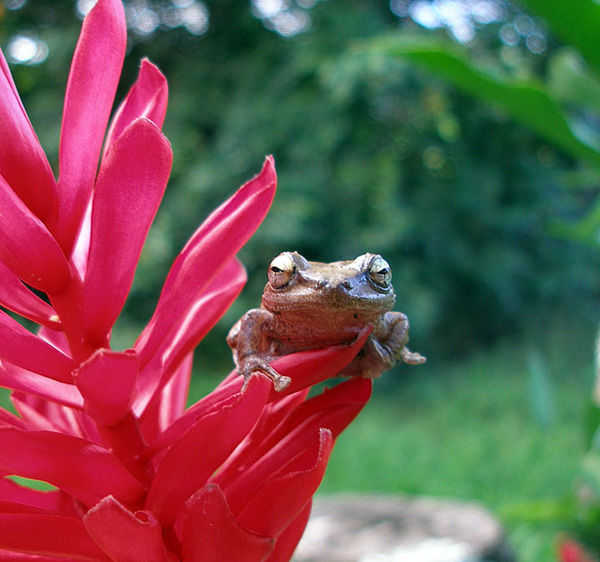Hawaii’s Inhumane Frog Policy
I received yet another call from someone distressed about coqui tree frogs on her property. No, she wasn’t wanting to find out how to kill the frogs. She was trying to find out how to keep them and resist aggressive neighbors wanting the frogs destroyed.
For many people in Hawaii, as in Puerto Rico, the coqui frog is considered an adorable creature, singing at night and improving the environment by eating insect pests. They can get loud in large numbers, but for those who enjoy the sounds of wildlife, the coqui chirp is soothing and creates a white noise that aids sleep.
However, the Hawaiian government has passed laws to vilify coqui frogs as a noisy environmental menace, making it illegal to “harbor” or transport coquis within the state. According to the law, coquis frogs are pests by definition, and anyone enjoying them does so at his own peril. Millions of dollars have been spent trying to stop the spread of the frogs, which now reside happily on the Big Island’s east side and in limited areas of the other islands.
Of course, if the coqui frogs were native to Hawaii, they would be protected, not killed. The sound would be appreciated and promoted, as it is in Puerto Rico.
However, in today’s Hawaii, only native species are valued. Introduced species are now regarded as illegal aliens, and harboring these aliens is against the law. Laws defining the coqui as a “pest” allow the cruel slaughter of these tiny, harmless creatures, bypassing humane treatment laws.
The Good Shepherd Foundation, of which I am the director, believes that cruelty to animals is unacceptable, regardless of whether the animals are native or not. In 2001 we started a program to counter the anti-coqui propaganda, called CHIRP, or the Coqui Hawaiian Integration and Reeducation Project. Acceptance, we believe, is better than an endless environmental war against the frogs.
Over the years we have been contacted by many residents who found the frogs desirable on their property, but who were being harassed by neighbors who did not yet have the frogs and wanted them eradicated. This meant having one’s property sprayed with citric acid, which kills plants as well as coquis, lizards, insects, and other non-target species. The acid burns the victims to death.
Anti-coqui hysteria has made people fearful of admitting they like the coquis, faced with the unfortunate choices of harassment, or letting eradicators poison their property.
Some residents would like to remove the coquis to avoid the drama, but don’t want to kill the coquis in the process. These humane-minded people are faced with another dilemma. Moving coquis is a crime. The government has made it so people can only kill coquis, either with citric acid or by cooking or freezing the live frogs. You can’t legally catch the frogs and release them somewhere else where there are other frogs.
This means the Hawaiian government has made it illegal to treat the coquis humanely. It forces residents to either be cruel to the frogs, or to break the law and illegally release the frogs elsewhere, which many people do.
The most recent phone call was from a woman who wanted to save the lone coqui on her property from a certain death. A neighbor heard the frog and reported it to the homeowner’s association, which was dispatching an eradicator right away. The neighbor also complained that this same woman was feeding non-native birds, and threatened to have the birds shot.
For those who love wildlife, Hawaii is no longer a paradise. Species are not valued for their beauty and other positive qualities, or for the biological diversity they bring to these volcanic islands. Instead, they are valued solely for being “native,” and are killed solely for being introduced.
It is a war on wildlife. Property owners, residents, and visitors who value wildlife for what it is, regardless of whether or not it was introduced, are victims of this war.
For more, see our website, www.HawaiianCoqui.org.
Guest post: Sydney Ross Singer is a medical anthropologist, author, and director of the Good Shepherd Foundation. He lives on a coqui frog sanctuary with his wife and son on the Big island of Hawaii.

